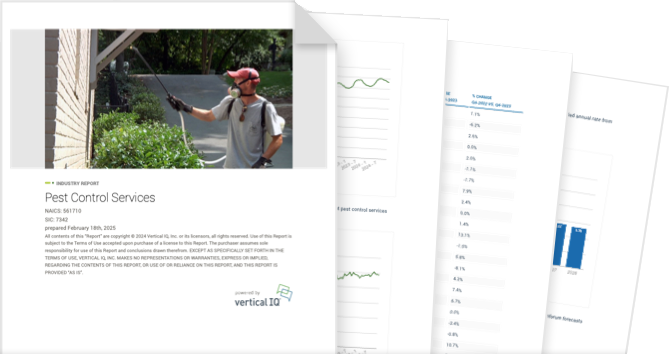Industrial Machinery Manufacturers NAICS 3332

Unlock access to the full platform with more than 900 industry reports and local economic insights.
Get access to this Industry Profile including 18+ chapters and more than 50 pages of industry research.
Industry Summary
The 2,700 industrial machinery manufacturers in the US produce the machines required to make other products. These can range from simple mechanical modules that perform a single function to complex computer-controlled machines that perform multiple processing functions. Key customer markets are woodworking, metals, plastics, paper, textiles, bookbinding, printing, food, and semiconductor production.
Pressure to Innovate
Manufacturing processes are becoming increasingly automated and computer-driven.
Dependence On Exports
Exports account for nearly two-thirds of US industrial machinery manufacturers’ revenue and create additional risks for manufacturers.
Recent Developments
Nov 30, 2025 - Factory Activity Shrinks Again in October
- US factory activity, which drives demand for the machines used to make other products, shrank in October for an eighth consecutive month, driven by a pullback in production and tepid demand, The Wall Street Journal reported in November citing the latest data from the Institute for Supply Management (ISM). In October, ISM’s Purchasing Managers’ Index (PMI) fell to 48.7 from 49.1 in September (a reading under 50 indicated contraction), with production, new orders, and employment all contracting, reversing short-lived gains seen in previous months. Six manufacturing industries reported growth in October with Primary Metals, Food, Beverage & Tobacco Products, and Transportation Equipment topping the list. Twelve industries reported contraction for the month including Textile Mills, Apparel, Leather & Allied Products, Furniture & Related Products, and Machinery. WSJ noted that tariffs and their impact on prices and demand featured highly in respondents’ answers to the ISM survey.
- The complex web of tariffs imposed by the Trump administration has infiltrated most segments of the US manufacturing technology supply chain, impacting everything from pricing and sourcing to investment timelines, a recent Association For Manufacturing Technology’s (AMT) survey of 80 manufacturing technology executives found. Reciprocal tariffs, Section 301 tariffs, 50% levies on steel and aluminum, and a pending Section 232 investigation of robotics and industrial machinery imports have added layers of complexity to pricing, sourcing, and production planning for US manufacturers across most of the supply chain, per AMT. The survey found 91% of respondents reported increased landed costs (the total cost of getting a product from the factory to a customer’s door) due to tariffs; 85% raised customer prices to offset those costs; and 85% experienced margin compression on imported machinery or components. Notably, only 9% of those surveyed reported switching suppliers.
- The Commerce Department in September initiated an investigation to determine the effects on national security of imports of robotics and industrial machinery, according to the Federal Register. The probe, opened under Section 232 of the Trade Expansion Act, will examine the national security implications of imports of a wide array of industrial equipment, including robots and programmable, computer-controlled mechanical systems, turning and milling machines, grinding and deburring equipment, and industrial stamping and pressing machines. Other items included are automatic tool changers, jigs and fixtures, and machine tools for cutting and welding. The investigation could result in tariffs on imports of such equipment. The department is seeking information on domestic production and demand, the role and risks of major foreign exporters, and the impact of foreign government subsidies and trade practices on the robotics and industrial machinery markets.
- Producer prices for industrial machinery manufacturers rose 2.2% in August compared to a year ago, after rising 3.5% in the previous August-versus-August annual comparison, according to the latest US Bureau of Labor Statistics data. Industry producer prices reached all-time highs this summer as manufacturers’ input costs rose. Employment by the industry inched up 0.4% year over year in July, while average wages at industrial machinery manufacturers climbed 7.5% over the same period to a new high of $32.26 per hour, BLS data show. New orders and shipments of industrial machinery rose sharply in July, up 18.4% and 17.1% YoY, respectively, per Census Bureau data.
Industry Revenue
Industrial Machinery Manufacturers

Industry Structure
Industry size & Structure
The average industrial machinery manufacturer has 49 employees and produces about $15.7 million in annual revenue.
- About 2,700 companies employ 133,000 workers and generate $42.6 billion in annual revenue.
- 63% of firms have fewer than 20 employees.
- About 145 facilities are very large, employing 500 or more workers.
- Large companies include Siemens AG, ABB, Honeywell, Ingersoll Rand, and Lam Research Corp.
Industry Forecast
Industry Forecast
Industrial Machinery Manufacturers Industry Growth

Vertical IQ Industry Report
For anyone actively digging deeper into a specific industry.
50+ pages of timely industry insights
18+ chapters
PDF delivered to your inbox
